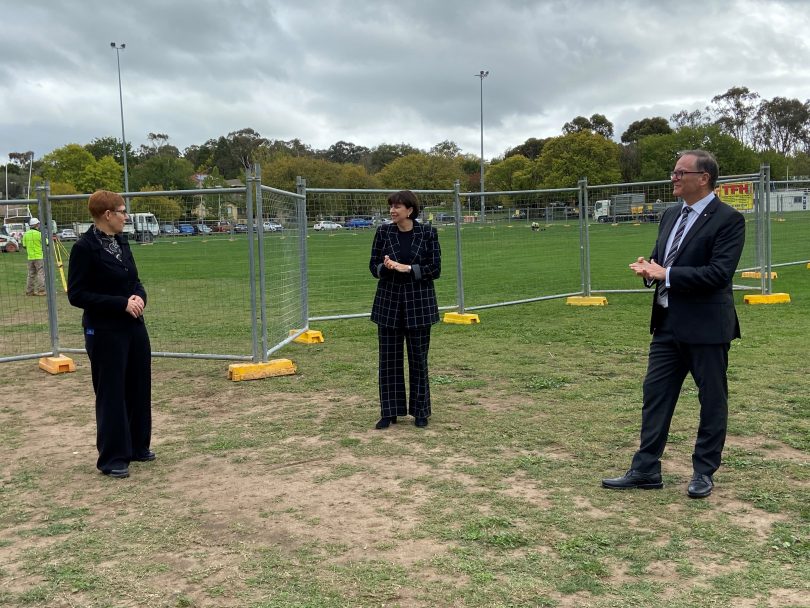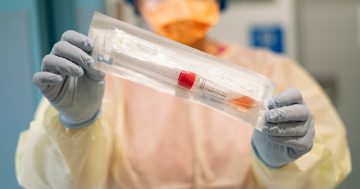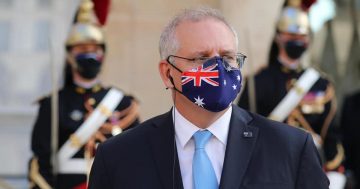
Health Minister Rachel Stephen-Smith (left), CEO of Canberra Health Services Bernadette McDonald (middle) and Executive Chairman of Aspen Medical Glenn Keys (right) announcing Garran Oval as the site for the temporary Emergency Department on 9 April. Photo: Region Media.
The temporary emergency department set to be erected at Garran Oval will go ahead as planned despite an improving COVID-19 situation, the Chief Minister confirmed yesterday (20 April).
The $23 million, 50-bed pop-up facility will help the ACT expand the capacity of its emergency health response as Canberra prepares for a possible uptick in COVID-19 cases, coupled with winter influenza presentations.
Health Minister Rachel Stephen Smith has previously said that the facility had been chosen to mitigate any interruptions to Canberra Hospital’s operations and is intended to be fully self-sufficient.
The structure is intended to be temporary and represents an important part of the plan to boost the ACT’s hospital capacity, tripling the number of intensive care beds from 50 to more than 170 in case the pandemic returns.
Chief Minister Andrew Barr said he understands the frustration of residents who want lockdown restrictions eased, especially after almost 90 per cent of COVID-19 cases have recovered; however, he said those calling for slackened measures are misunderstanding the cyclical nature of a pandemic.
That possibility is what drives the decision to continue with the new emergency facility plans.
“I am worried about public frustration at the lockdowns but I did say this from the start, that decisions we took now were going to have long-term implications that were going to be beyond just a period of weeks – they were going to be months and potentially years,” Mr Barr said.
“The history of the Spanish Flu a century ago was that the second wave was significantly larger than the first and far more deadly. This virus will continue to circulate around Australia even if it stops in the ACT and all it takes is one person to begin another chain of infection.
“While it is possible for an island nation to pursue an elimination path, it is a short-term elimination path because this virus will continue to circulate around the world for many years – any early move out of restrictions runs the risk of a second or third or fourth or fifth wave.”
The Territory’s Chief Health Officer (CHO), Dr Kerryn Coleman, says she is hoping we can achieve complete eradication of COVID-19 in the ACT as less than a dozen people are active with the virus, but that the main aim of ACT Health is confidently identifying any transmission sources rapidly.
“When we start relaxing some of our social distancing measures and start to see movement further around the country is when our risk will re-raise because we are at a much lower risk than other jurisdictions,” she said.
“That will be a really important time to be monitoring our testing more closely.”
However, Mr Barr reminded Canberrans that even if the virus is eradicated in the territory or in Australia, there would be no immunity in the community until a vaccine is created.
At the very least, Australia would have to remain closed to overseas travellers and ban citizens from leaving the country as one person could potentially start another outbreak upon entry, Mr Barr says.
“There is a lot of work going into looking at how we can shape a series of measures that are less restrictive than where we are at now but that still provides some level of protection,” he said.
“We cannot completely eliminate the risk but you can make some sensible risk reduction and risk minimisation decisions and measures, and some are as straight forward as closing Australia’s borders and others go to limiting the size of public gatherings.”















